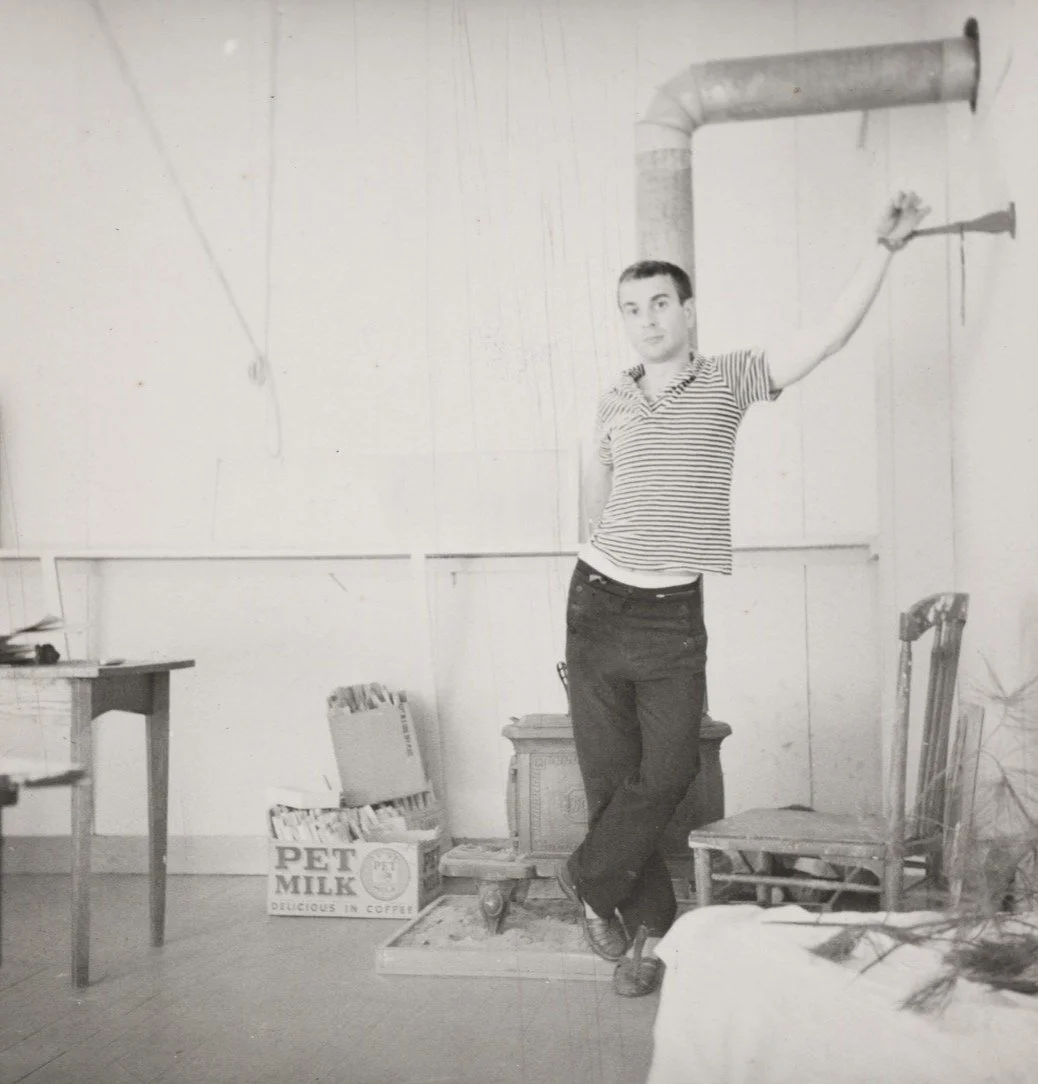
Dudley Huppler
A precocious, self-taught artist, Dudley Huppler (1917-1988) studied English at UW-Madison in the late 1930s and joined Marshall Glasier’s salon, which included Midwestern Surrealists like Karl Priebe, John Wilde, Sylvia Fein, and Gertrude Abercrombie. In the 1940s, encouraged by friends including Wilde, Huppler begins making drawings, and in 1947, developed his signature stipple-dot technique, working almost exclusively with ink on paper for the majority of his career.
In 1949, Huppler began spending significant time in New York City, where through his art, ambition and natural talents, he penetrated the innermost circles of cultural aristocracy. By the time of his arrival, his work was already widely known through postcard reproductions of his drawings, and soon his work would find its way into the hands of collectors including W.H. Auden and Ezra Pound. The same year, he would befriend renowned photographer George Platt Lynes, who introduced him to many of the leading gay cultural figures of the time. Writing to Gertrude Abercrombie in February, 1950, Huppler remarks, “Oh did I ever get a welcome from Paul Cadmus and Jared French and a nice new painter called George Tooker, a cute name…I might as well be in Europe, I’m that happy.” In 1954, he first became acquainted with Andy Warhol and collaborated with him on various projects, meanwhile, in letters to his Priebe, he conveyed some private jokes about the budding art superstar.
Despite his myriad connections with the gay art community, it was not until the late-1960s that Huppler was comfortable being fully “out” in his work. As art historian Robert Cozzolino writes, “The work on which Huppler’s reputation was founded is filled with puns, symbols, and in-jokes that simultaneously reveal and veil his sexuality.”
Throughout the 1970s, Huppler gradually abandoned his signature stipple technique in favor of a more “traditional” drawing method. From the mid-1960s until his retirement in the mid-1980s, he would teach English at The University of Wisconsin, Oshkosh.
Dudley Huppler, Rome (Owl in Trees), 1953, ink on paper, 9 3/4 x 5 3/4 inches
Dudley Huppler, Pika Hare on Nailsea Weight, c. 1956, ink and casein on paper, 9 3/4 x 7 inches
Dudley Huppler, Mouse in a Walnut Shell, c. 1960, ink and casein on paper, 4 1/4 x 6 inches
Dudley Huppler, Bella Italia, set of ten vintage postcards, c. 1950s, privately printed for sale at Serendipity in New York, 5 3/4 x 3 1/2 inches (each)
Dudley Huppler (cover illus.), Poetry (August 1971), offset print on laid paper, 9 x 5 1/2 inches
Dudley Huppler (cover illus.), Poetry, Vol. CXVI no. 3 (June 1970), offset print on laid paper, 8 x 5 1/2 x 1/4 inches
Robert Cozzolino, With Friends: Six Magic Realists, 1940-65, catalogue for group exhibition featuring Gertrude Abercrombie, Sylvia Fein, Marshall Glasier, Dudley Huppler, Karl Priebe, and John Wilde, Elvehjem Museum of Art, University of Wisconsin-Madison, 2006, 11 x 8 1/2 inches
Dudley Huppler: Drawings, exhibition catalogue for show curated by Robert Cozzolino at the Elvehjem Museum of Art, Madison, Wisconsin, 2002, 11 x 8 1/2 inches
(Left to Right) Dudley Huppler, Keith Ingermann, unknown man, Jean Jones Jackson, Piero Aversa, unknown man. Alice DeLamar Estate, Palm Beach, FL, n.d.. Courtesy of Nona Footz.
Carl Van Vechten, Portrait of Dudley Huppler, 1950, gelatin silver print, 8 3/4 x 6 1/8 inches. Philadelphia Museum of Art, gift of John Mark Lutz, 1965.
(left to right) Karl Priebe, Gertrude Abercrombie, Dudley Huppler, and unidentified couple, c. 1944. Gertrude Abercrombie papers, circa 1880-1986. Archives of American Art, Smithsonian Institution.
Alice DeLamar Estate, Palm Beach, FL, n.d.. Courtesy of the Estate of Sandy Jackson.
Dudley Huppler, Rome, 1953. Photo by Lee Hoiby.
Dudley Huppler in his studio at Yaddo, c. 1953. Gertrude Abercrombie papers, circa 1880-1986. Archives of American Art, Smithsonian Institution.
Dudley Huppler, Alice DeLamar Estate, Palm Beach, FL, nd. Courtesy of Nona Footz.
George Platt Lynes, Advertisement for Henri Bendel featuring three of Huppler's drawings, 1950.
(left to right) Gertrude Abercrombie, unidentified man and woman, Dudley Huppler, Karl Priebe, and unidentified woman, c. 1944. Gertrude Abercrombie papers, circa 1880-1986. Archives of American Art, Smithsonian Institution.
Dudley Huppler, 1953. Gertrude Abercrombie papers, circa 1880-1986. Archives of American Art, Smithsonian Institution.
Dudley Huppler in his studio, nd. Courtesy of Dudley Huppler Estate.



















